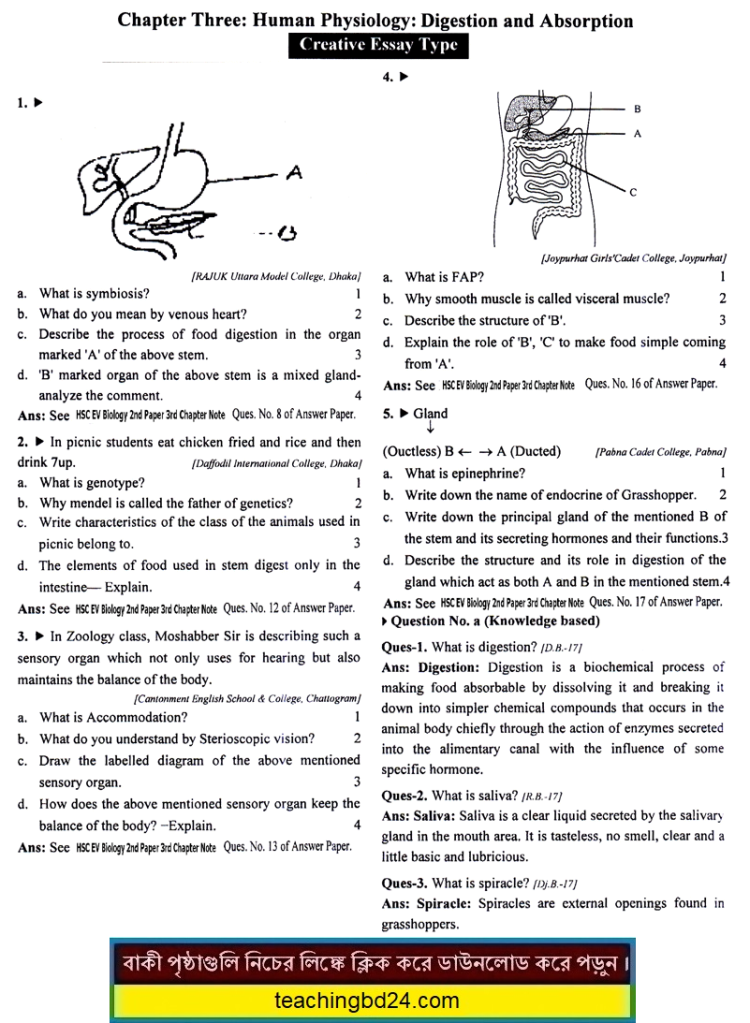EV HSC Biology II 3rd Chapter MCQ Question Answer. Human Digestion and Absorption. Human digestive system, the system used in the human body for the process of digestion. The human digestive system consists primarily of the digestive tract or the series of structures and organs through which food and liquids pass during their processing into forms absorbable into the bloodstream. The system also consists of the structures through which wastes pass in the process of elimination and other organs that contribute juices necessary for the digestive process.
The human digestive system consists of the gastrointestinal tract plus the accessory organs of digestion (the tongue, salivary glands, pancreas, liver, and gallbladder). Digestion involves the breakdown of food into smaller and smaller components until they can be absorbed and assimilated into the body. The process of digestion has many stages. The first stage is the cephalic phase of digestion which begins with gastric secretions in response to the sight and smell of food. The next stage starts in the mouth.
Digestion is the breakdown of large insoluble food molecules into small water-soluble food molecules so that they can be absorbed into the watery blood plasma. In certain organisms, these smaller substances are absorbed through the small intestine into the bloodstream. Digestion is a form of catabolism that is often divided into two processes based on how food is broken down: mechanical and chemical digestion. The term mechanical digestion refers to the physical breakdown of large pieces of food into smaller pieces which can subsequently be accessed by digestive enzymes. In chemical digestion, enzymes break down food into the small molecules the body can use.
EV HSC Biology II 3rd Chapter MCQ Question Answer. Human Digestion and Absorption

EV HSC Biology 2nd Paper MCQ Question With Answer

Biology is the natural science that studies life and living organisms, including their physical structure, chemical processes, molecular interactions, physiological mechanisms, development, and evolution. Botany, also called plant science(s), plant biology or phytology, is the science of plant life and a branch of biology.
The fields within biology are further divided based on the scale at which organisms are studied and the methods used to study them: biochemistry examines the fundamental chemistry of life; molecular biology studies the complex interactions of systems of biological molecules; cellular biology examines the basic building block of all life, the cell; physiology examines the physical and chemical functions of the tissues and organ systems of an organism, and ecology examines how various organisms interrelate.
A botanist, plant scientist or phytologist is a scientist who specializes in this field. Zoology is the scientific study of animals. This discipline can include animal anatomy, physiology, biochemistry, genetics, evolution, ecology, behavior, and conservation.
The proper function of human bodies is dependent on smaller structures, or organs, such as the heart or lungs. The tiny cells that make up these organs actually contain within them smaller structures called organelles. These organelles help the cells to perform their jobs. In cancer, changes to these organelles can cause the individual cells and ultimately the entire organism to have serious problems. To get a better understanding of how cells work, we will now spend some time examining some of these subcellular structures.
The organelles that we will discuss are involved in the information flow within cells and in energy production. In addition, we will look at a structure that gives cells their shape and allows them to reproduce themselves. All of the organelles and processes to be discussed have direct relevance to cancer because these are the cellular structures/activities that become disturbed in the disease.
The image below shows two living mouse cells. The mitochondria are colored red and the nuclei (with brightly stained chromosomes) are colored blue. The green colored region near the nuclei of the cells represents the Golgi apparatus, an organelle involved in the processing and packaging of molecules within the cell.
teachingbd24.com is such a website where you will get all kinds of necessary information regarding educational notes, suggestions and question patterns of schools, colleges, and madrasas. Particularly, you will get here special notes of physics that will be immensely useful to both students and teachers. The builder of the website is Mr. Md. Shah Jamal who has been serving for 32 years as an Assistant Professor of Physics at BAF Shaheen College Dhaka. He expects that this website will meet up all the needs of Bengali version learners /students. He has requested concerned students and teachers to spread this website home and abroad.
EV HSC Biology 2nd Paper MCQ Suggestion Question Answer
Discover more from Teaching BD
Subscribe to get the latest posts sent to your email.

